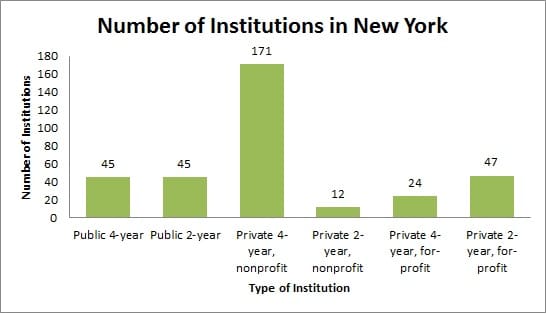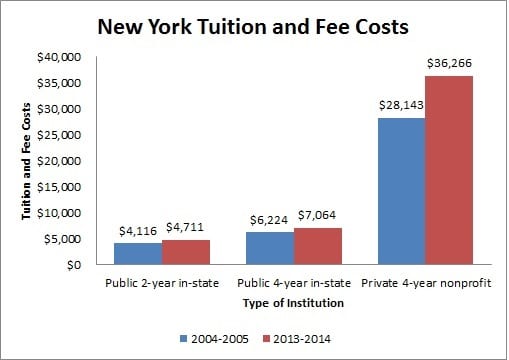Education in New York
According to 2013 estimates from the U.S. Census Bureau, the state of New York is home to more than 19.6 million residents, many of whom have pursued higher education in some form during their lifetime. A recent report from the Lumina Foundation stated that approximately 45.1 percent of the state’s residents held at least a two-year degree in 2012, compared to 2008 when only 43.8 percent of residents could say the same.
New York State Education Department data shows that 556,040 students were enrolled in full-time undergraduate programs in 2013, in addition to 108,880 full-time graduate students. Meanwhile, 274,860 New York students pursued undergraduate degrees on a part-time basis on 2013, and 94,568 students pursued a graduate degree part-time.
Because of the growing demand for degrees in the state, plenty of colleges and universities in New York have stepped up to the plate in terms of their educational offerings. The National Center for Education Statistics (NCES) counts 341 different public and private colleges and universities in New York. Of those 45 are public 4-year schools and 45 are public 2-year schools. 171 are private 4-year not-for-profits and 12 are private 2-year non-for-profits. Among for-profit schools, 24 are 4-year institutions, while 47 are 2-year for-profits.

Online education in New York
While many New York residents opt to earn a college degree at a traditional school, a growing amount of students choose to earn a degree online. Fortunately, the state is home to Open SUNY, the State University of New York’s collaborative effort aimed at bringing online education to the forefront. Currently, Open SUNY encompasses the collective efforts of 64 different college campuses that offer online courses and degree programs in the state.
Of course, a number of the larger colleges and universities in New York offer their own online offerings as well, and it makes perfect sense why they do. Students who work full-time or have family responsibilities often choose online degree programs so they can pursue higher education on nights and weekends without neglecting their duties. Online degree programs have also become particularly popular with working adults who go back to school to earn a graduate degree since studying online allows them to continue their career while they learn new skills.
Here’s a list of some of the standout online colleges and university programs in New York based on rankings from U.S. News and World Report:
- Columbia University
- Best Online Graduate Engineering Programs: #2
- New York University
- Best Online Graduate Engineering Programs: #8
- Pace University
- Best Online Bachelor’s Programs: #10
- Best Online Graduate Computer Information Technology Programs: #9
- Best Online Graduate Criminal Justice Programs: #2
- Syracuse University
- Best Online MBA Programs: #57
- Best Online Graduate Computer Information Technology Programs: #9
Top careers in New York
The state of New York has plenty to offer in terms of potential employment. Those opportunities aren’t limited to regions surrounding the big cities in the state like New York City and Newark either. Several of the top careers in New York can be pursued throughout the state.
The U.S. Department of Labor’s CareerOneStop offers information on careers with the most potential for growth in all states, including New York. Combining that data with Bureau of Labor Statistics wage and employment data, we’ve come up with this list of top careers in New York:
| Occupation | Top regions | Growth prospects | Necessary skills | Relevant degrees |
|---|---|---|---|---|
| Meeting, Convention, and Event Planners | The New York-White Plains-Wayne, NY-NJ Metropolitan Division, employs 5,680, and the Newark-Union area employs 540. | According to U.S. Bureau of Labor Statistics figures, employment for meeting, convention, and event planners is expected to increase up to 42 percent in New York during the decade leading up to 2022. | The BLS states that many in this field have backgrounds in marketing, public relations, communications, or business. | Meeting, convention, and event planners often earn a bachelor’s degree in hospitality management or a related field. According to the BLS, meeting, convention and event planners who start out with a bachelor’s degree in hospitality management may start out with more responsibility than those with a degree in another field. |
| Interpreters and Translators | In 2013, the state of New York can employed the second highest number of interpreters and translators in the country. The New York-White Plains-Wayne, NY-NJ Metropolitan Division was home to 2,510 interpreters and translators. | U.S. Department of Labor figures show that jobs for interpreters and translators are also expected to be plentiful in the coming decade. Specifically, they project that the number of jobs for these professionals in New York will increase 41 percent from 2012 to 2022. | Students who plan to pursue a career in this field should study other cultures and languages they find interesting, as well as English writing and comprehension. | Employment requirements for interpreters and translators vary widely, according to the BLS. However, most employers prefer to hire professionals who hold a Bachelor’s degree. |
| Food Scientists and Technologists | In 2013 New York posted the following employment numbers for food scientists and technologists in these metropolitan areas: Buffalo-Niagara Falls: 90, Nassau-Suffolk: 40, New York-Northern New Jersey-Long Island: 480, New York-White Plains-Wayne: 230 | Thanks to a growing demand to keep our food sources safe, the need for food scientists and technologists is on the rise. According to U.S. Department of Labor Data, this is especially true in the state of New York where employment in this field is expected to increase 38 percent from 2012 to 2022. | Undergraduate coursework for agricultural and food scientists often includes topics like biology, chemistry, and botany. | According to the BLS, food scientists most often earn Bachelor’s degrees in a related field, and some pursue Master’s degrees or even Doctoral degrees. |
| Market Research Analysts | Some regions in New York employed more market research analysts than others. For example, the New York-White Plains-Wayne, NY-NJ Metropolitan Division employed 31,810 and the Syracuse, New York region employed 940. | U.S. Department of Labor figures show that the open positions for market research analysts in New York could increase by as much as 34 percent from 2012 to 2022. | The BLS reports that market research analysts need excellent math and analytical skills. | Many market research analysts also begin their career by earning a degree in statistics, math, or computer science. Students interested in a career as a market research analyst can study advanced math in school and choose a college major in one of these fields. |
| Logisticians | These regions in New York employed the following number of logisticians: New York-White Plains-Wayne, NY-NJ Metropolitan Division: 2,060, Poughkeepsie-Newburgh-Middletown: 80, Albany-Schenectady-Troy:: 150, Capital-Northern New York: 90, Utica-Rome: 70 | The U.S. Department of Labor data predicts that jobs for this career will increase 26 percent in New York from 2012 to 2022. | Common skills used to enter this field are in business, industrial engineering, process engineering and supply chain management | Most logisticians have a Bachelor’s degree, notes the BLS, although a small number of professionals gain employment with an Associate’s degree. |
New York financial aid
According to figures provided by The College Board, college tuition for the 2013-14 school year averaged out to $6,919 for in-state students. In its comparison of 2004-2005 tuition and fee costs to 2013-2014’s, College Board found in-state costs for students at public 2-years to have increased from $4,116 to $4,711. In-state costs for 4-year private not-for-profit institutions increased from $28,143 to $36,266, while public four-year schools moved from $6,224 to $7,064.

New York financial aid can help lessen the burden even further. The New York State Higher Education Services Corporation lists the various kinds of financial aid that may be available to New York students, including these types:
Federal Grants
- Pell Grants
- Federal Supplemental Educational Opportunity Grant
- TEACH Grants
- Iraq and Afghanistan Service Grants
State Grants
- Tuition Assistance Program (TAP)
- Part-time TAP
- NYS Aid for Part-time Study
- NYS Educational Opportunity Program
Federal Loans
- Federal Direct Loan Programs
- Federal Perkins Loan Program (expired 9/30/17, although Congressional bills have been introduced that support its extension)
- Federal Direct PLUS Loan Program
- Federal Direct Graduate/Professional PLUS Loan Program
Various loan forgiveness programs are offered in the state of New York as well, as are state-specific scholarships for a wide range of college majors.
To find out more about some of the schools and programs available in New York, be sure to check out the ones featured in our school listings below.
Sources:
- U.S. Bureau of Labor Statistics, Occupational Employment and Wages, May 2013: “Meeting, Convention, and Event Planners,” http://www.bls.gov/oes/current/oes131121, “Food Scientists and Technologists,” http://www.bls.gov/oes/current/oes191012, “Interpreters and Translators,” http://www.bls.gov/oes/current/oes273091, “Market Research Analysts and Marketing Specialists,” http://www.bls.gov/oes/current/oes131161, “Logisticians,” http://www.bls.gov/oes/current/oes131081
- U.S. Bureau of Labor Statistics, Occupational Outlook Handbook, 2014-2015 Edition: “Logisticians,” http://www.bls.gov/ooh/business-and-financial/logisticians#tab-1, “Market Research Analysts,” http://www.bls.gov/ooh/business-and-financial/market-research-analysts#tab-1, “Meeting, Convention, and Event Planners,” http://www.bls.gov/ooh/business-and-financial/meeting-convention-and-event-planners#tab-1, “Agricultural and Food Scientists,” http://www.bls.gov/ooh/life-physical-and-social-science/agricultural-and-food-scientists#tab-1, “Interpreters and Translators,” http://www.bls.gov/ooh/media-and-communication/interpreters-and-translators#tab-1
- Bureau of Labor Statistics, “May 2013 Occupational Employment and Wage Estimates,” New York, http://www.bls.gov/oes/current/oes_ny
- “A Stronger Nation through Higher Education,” Lumina Foundation, New York, http://strongernation.luminafoundation.org/report/#new-york
- “Degree Credit Enrollment, Fall: 2013,” New York State Education Department, http://eservices.nysed.gov/orisre/mainservlet
- “NCES College Navigator, National Center for Education Statistics http://nces.ed.gov/collegenavigator/?s=NY&l=93
- “State and County QuickFacts,” United States Census Bureau, New York, http://quickfacts.census.gov/qfd/states/36000
- “Top 50 Fastest Growing Occupations,” CareerOneStop, http://www.careerinfonet.org/oview1.asp?next=oview1&Level=edu3&optstatus=&jobfam=&id=1&nodeid=3&soccode=&ShowAll=&stfips=36
- “Tuition and Fees by Sector and State over Time,” College Board, http://trends.collegeboard.org/college-pricing/figures-tables/tuition-and-fees-sector-and-state-over-time
- “Types of Financial Aid,” New York State Higher Education Services Corporation, http://www.hesc.ny.gov/
- “What is Open SUNY?” Open SUNY, http://open.suny.edu/about/what-is-open-suny/
